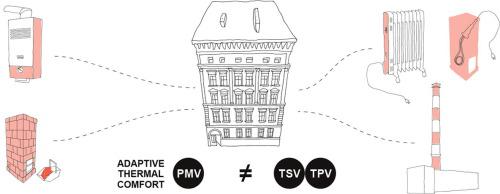Energy and Buildings ( IF 6.6 ) Pub Date : 2021-06-10 , DOI: 10.1016/j.enbuild.2021.111178 Magdalena Baborska-Narożny , Marta Laska , Natalia Fidorów-Kaprawy , Martyna Mokrzecka , Małgorzata Małyszko , Marta Smektała , Ewelina Stefanowicz , Krzysztof Piechurski

|
Providing thermal comfort in residential buildings in winter by solid fuel combustion is a significant source of emissions that contribute to air pollution and climate change. In this field study, we investigated thermal comfort in tenements (16 apartments) equipped with heating systems prevalent in Polish urban historical buildings, i.e. solid fuel stoves, electric heating, district-supplied central heating, or individual gas boilers. Our research comprised spot check multi-parameter measurements and continuous monitoring of the thermal environment, together with a longitudinal thermal comfort questionnaire survey (N = 0.2539). Differences were detected in the thermal environments depending on the heating system. In our sample solid fuel heating was associated with a thermal environment on average 3.3 °C colder than those heated by gas central heating. The inferiority of thermal comfort conditions associated with solid fuel was shown by predicted mean vote and adaptive thermal comfort analyses. However, the survey results on individual thermal sensations and preferences did not confirm these findings. Therefore, activating the residents to expedite the transition from solid fuel heating might not be supported effectively by the “lack of thermal comfort” narrative. Accordingly, we identified a need for further studies investigating the link between domestic thermal comfort and satisfaction with control over the cost of heating.
中文翻译:

历史悠久的多户建筑中的热舒适性和固体燃料加热的过渡——波兰的真实世界研究
通过固体燃料燃烧在冬季为住宅建筑提供热舒适度是导致空气污染和气候变化的重要排放源。在这项实地研究中,我们调查了公寓(16 套公寓)的热舒适性,这些公寓配备了波兰城市历史建筑中普遍存在的供暖系统,即固体燃料炉、电供暖、区域集中供暖或单独的燃气锅炉。我们的研究包括抽查多参数测量和热环境的连续监测,以及纵向热舒适问卷调查 (N = 0.2539)。在取决于加热系统的热环境中检测到差异。在我们的样本中,固体燃料加热与平均 3 的热环境相关。比燃气集中供暖加热的温度低 3°C。预测平均投票和自适应热舒适性分析显示了与固体燃料相关的热舒适条件的劣势。然而,关于个人热感觉和偏好的调查结果并未证实这些发现。因此,“缺乏热舒适性”的说法可能无法有效地支持居民加快从固体燃料供暖的转变。因此,我们确定需要进一步研究调查家庭热舒适度与对供暖成本控制的满意度之间的联系。关于个人热感觉和偏好的调查结果并未证实这些发现。因此,“缺乏热舒适性”的说法可能无法有效地支持居民加快从固体燃料供暖的转变。因此,我们确定需要进一步研究调查家庭热舒适度与对供暖成本控制的满意度之间的联系。关于个人热感觉和偏好的调查结果并未证实这些发现。因此,“缺乏热舒适性”的说法可能无法有效地支持居民加快从固体燃料供暖的过渡。因此,我们确定需要进一步研究调查家庭热舒适度与对供暖成本控制的满意度之间的联系。







































 京公网安备 11010802027423号
京公网安备 11010802027423号